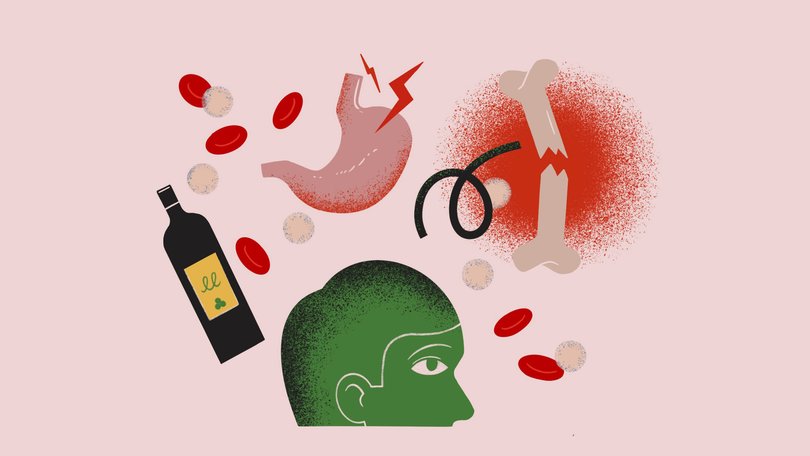WASHINGTON POST: Four surprising cancer symptoms you need to know, according to an oncologist

As an oncologist, I see patients who report both common and uncommon symptoms.
The symptoms most commonly linked to a cancer diagnosis, not surprisingly, reflect the incidence rates of the world’s most prevalent cancers. These include feeling a breast lump, urinary tract symptoms, a change in bowel habits or a chronic cough, which can respectively signal underlying cancers of the breast, prostate, colon or rectum, or lung.
But there are also lesser-known symptoms that may indicate an underlying cancer. Here are four surprising symptoms that should prompt you to seek evaluation by a doctor. Keep in mind that these are rare and unusual, and not every twinge is cancer. If you’re worried about a new symptom, see your doctor, who can tell you if it’s something to be concerned about.
Sign up to The Nightly's newsletters.
Get the first look at the digital newspaper, curated daily stories and breaking headlines delivered to your inbox.
By continuing you agree to our Terms and Privacy Policy.Pain in a lymph node after drinking alcohol
I cared for a patient years ago who told me she had chest pain that lasted a day or two every time she drank a glass of wine. A CT scan of her chest uncovered a large mass in her lungs, and sure enough, a biopsy confirmed that it was Hodgkin lymphoma.
Many people experience pain or irritation after drinking alcohol in the lower chest or abdomen due to inflammation of the oesophagus or stomach — conditions called oesophagitis or gastritis, which can often be relieved with antacids or proton pump inhibitors.
But pain in a discrete area of the body occurring consistently following alcohol ingestion — such as in a lymph node or the lower back — may be a sign of this cancer.
In one study, the phenomenon was found in at least 5 per cent of people diagnosed with Hodgkin lymphoma. The pain is thought to be due to dilation of blood vessels in the lymph node from alcohol intake or the release of inflammatory chemicals.
A broken bone with very little trauma
I’ve broken a number of bones over my lifetime, from falling from a bike at high speed or participating in athletic activities in which I wasn’t quite the athlete I thought I was. While bone density and strength can decline with age, leading to approximately two million osteoporosis-related fractures yearly in the United States, a broken bone with little provocation is rare, particularly in younger adults.
These types of fractures can, in some cases, indicate an underlying cancer.
Cancer that starts in or spreads to the bone can weaken the bone’s strength, leading to “pathologic” fractures.
About 5 per cent of cancers involve the bone.
Among people with cancer in the bone, approximately 8 per cent sustain a pathologic fracture. These types of broken bones are 500 times more likely to occur due to cancer spreading to bone as opposed to a primary bone cancer, with the most common cancers originating in the breast, lung, thyroid, kidney and prostate. Cancers involving the bone can be identified using X-rays, CT scans, MRIs or bone scans.
Sky-high calcium levels
Several conditions can lead to high calcium levels, such as abnormalities of the parathyroid gland, hyperthyroidism or even certain medications. However, in one study of over 50,000 people in a primary care practice, those with elevated calcium levels also had more than twice the risk of being diagnosed with cancer in the following year than those with normal levels, though the total number of people diagnosed with cancer was low. The risk of being diagnosed with cancer increased with progressively higher calcium levels.
People with high calcium levels due to cancer usually have symptoms related to the high calcium levels: pain from kidney stones and in skeletal bones, nausea or constipation, and behavioural disturbances including mood changes or altered cognitive function.
The most common cancers that cause high calcium levels include certain types of lung cancer, breast, kidney, bladder, ovarian, lymphoma and multiple myeloma, either through secretion of a hormone, or by destroying bones and causing calcium release into the bloodstream.
Painful, swollen breasts or nipple discharge
A benign condition called mastitis can cause painful, swollen or itchy breasts, and it’s most common in people who are breastfeeding. Mastitis is an inflammatory process that is painful and may require medical attention, but it is not cancer.
If you aren’t breastfeeding and experience these symptoms, this could be a sign of inflammatory breast cancer, which accounts for 2 to 4 per cent of breast cancer cases in the United States. Onset can be rapid and is typified by skin changes called peau d’orange, in which the breast skin changes and resembles the slightly pitted surface of an orange peel. If this happens, see a doctor, and if treatments such as cold packs, nons-teroidal drugs or antibiotics (which usually work for mastitis) are not successful, a breast biopsy may be needed.
Most episodes of nipple discharge are also benign: Among people who undergo surgery for the condition, only 2 to 15 per cent were found to have an underlying breast cancer. The most common causes of nipple discharge are mastitis, pregnancy, hormone imbalances or even injury. Discharge is more likely to be caused by cancer, however, when it occurs in only one breast, is intermittent and persists over time.
Keep in mind that we all worry that a new pain or blood test result out of the normal range could signal a serious diagnosis such as cancer. Usually, symptoms like these indicate relatively innocent diagnoses. But you should always reach out to your doctor to rule out anything concerning.
Mikkael A. Sekeres, MD, MS, is the chief of the division of hematology and professor of medicine at the Sylvester Comprehensive Cancer Center, University of Miami. He is author of the books “When Blood Breaks Down: Life Lessons from Leukemia” and “Drugs and the FDA: Safety, Efficacy, and the Public’s Trust.”
Special to The Washington Post
